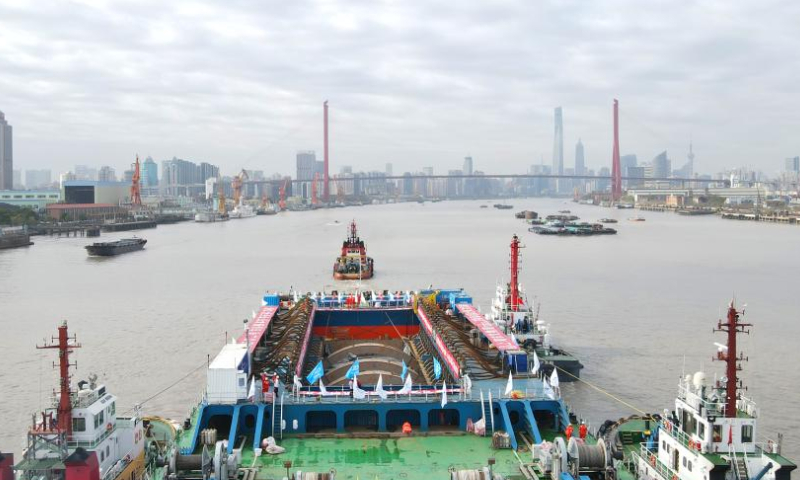
The Yangtze No. 2 Ancient Shipwreck is transferred to a dock near the Huangpu River in Shanghai, east China, Nov. 25, 2022. The ancient shipwreck, one of the largest and best-preserved wooden shipwrecks discovered underwater in China to date, was lifted out of waters in Shanghai early Monday. The Yangtze No. 2 Ancient Shipwreck dates back to the reign of Emperor Tongzhi (1862-1875) of the Qing Dynasty. This salvage could offer a useful glimpse of shipbuilding technology during the Qing Dynasty. (Xinhua/Fang Zhe)
Covering more than 31,000 square meters, China's National Base for Underwater Archaeology (South China Sea) has been officially put into operation with the aim of furthering China's underwater archaeology research.
The new base has dedicated areas such as a ship repair port and separate buildings for training, research and administration. On February 18, an opening ceremony led by China's National Cultural Heritage Administration was held in Hainan Province.
China's Vice Minister of Culture and Tourism Li Qun, also head of the administration, said at the event that the new base is an important project for protecting underwater relics in China.
Besides its important role in protecting Chinese culture, the base is also significant for its role in "safeguarding national sovereignty, security and maritime rights," Li added.
Qin Guangyi, an underwater archaeologist, told the Global Times that considering the scale of the South China Sea's underwater resources, the new base is a strategic platform that "integrates all the most needed procedures for underwater research into one system."
"Underwater excavation is far more complicated than 'salvage' operations. It is also important to know how to repair and preserve relics. And it is important to train more experts in this, especially when dealing with projects in the South China Sea," Qin added.
As an important section of the Maritime Silk Road, the South China Sea is China's top spot for underwater cultural heritage resources.
For example, the Nanhai No.1, a Song Dynasty (960-1279) shipwreck, is the most dazzling pearl discovered in the region. In 2019, more than 180,000 artifacts were found at the site of the 800-year-old ship.
In 2020, 32 underwater archaeological spots were discovered in the South China Sea. A batch of Yuan Dynasty (1279-1368) blue and white porcelains were the highlight of a 2010 project.
"These discoveries show how ancient Chinese' overseas trade expanded after the Song Dynasty," Fang Liming, a maritime historian in Xiamen, told the Global Times.
"Unlike other types of relics such as copper products, porcelain wares were symbols of Chinese culture and taste and also demonstrate the cultural exchanges that took place along the Maritime Silk Road," Qin said.
Besides the projects in the South China Sea, multiple other underwater projects have been carried out around the country, like the Yangtze River Estuary No.2 project.
During the salvage of the site, China's largest and best-preserved wooden shipwreck, more than 600 ancient relics were uncovered, alongside exquisite green porcelain wares.
Liu Zheng, a member of the China Cultural Relics Academy, told the Global Times that green glaze porcelain produced in China was inspired by European porcelain-making techniques.
"Such porcelain items show how well China could 'digest' Western culture and that it embraced this culture 100 years ago," Liu emphasized.




